Superfund Sites in Reuse in North Carolina
If you are having trouble viewing the map in your browser, click the 'View larger map' link below
Aberdeen Pesticide Dumps
The Aberdeen Pesticide Dumps Superfund site occupies about 33 acres near Aberdeen in Moore County, North Carolina. The site includes a former pesticide formulation plant (the Farm Chemicals Area) and four non-contiguous waste disposal areas. The waste disposal areas include the Twin Sites Area, the Fairway Six Area, the McIver Dump Area and the Route 211 Area. Pesticide formulation and related waste disposal practices contaminated soil, sediment, surface water and groundwater. Between 1985 and 1989, EPA and the responsible parties conducted cleanup activities at the five site areas. Cleanup included the removal of contaminated soil, demolition of contaminated buildings and groundwater cleanup. In 1989, EPA added the site to the National Priorities List (NPL). Soil cleanup is now complete. Water treatment and monitoring is ongoing. The Farm Chemicals Area is now home to an industrial and construction supply store, a gourmet coffee roaster and a commercial mini-storage warehouse facility. The Twin Sites Area now provides recreation opportunities for the community, supporting a walking trail, pedestrian bridge and fishing in Pages Lake.
Last updated September 2019
As of December 2019, EPA had data on 2 on-site businesses. These businesses employed 8 people and generated an estimated $4,742,000 in annual sales revenue. For additional information click here.
For more information:
Barber Orchard
The 438-acre Barber Orchard Superfund site is located just outside of Waynesville, North Carolina. From 1908 to 1988, Barber Orchard grew apples for commercial markets. The growers used pesticides and insecticides on trees and fruit. The growers pumped these chemicals across the property using underground piping. After foreclosing on the site property in 1988, the bank divided the land into several parcels and sold them for various uses. In the late 1990s, investigations found that the long-term use of pesticides and leaking pipes had contaminated site soil and groundwater. From 1999 to 2001, EPA and the North Carolina Department of Environment and Natural Resources (NCDENR) removed contaminated soil from the yards of 28 homes. EPA added the site to the National Priorities List (NPL) in September 2001. In 2004 and 2005, the town of Waynesville connected 32 parcels at the site to the public water supply. In 2010 and 2011, EPA and NCDENR cleaned up remaining site contamination. Long-term groundwater monitoring is ongoing. Agricultural production, homes, a church, and commercial and light industrial businesses are located on parts of the site. Since completion of the soil cleanup, four new homes have been built on the site. EPA expects that most of the vacant land remaining at the site will be developed as a residential area.
Last updated September 2019
As of December 2019, EPA had data on 4 on-site businesses. These businesses employed 32 people and generated an estimated $1,330,000 in annual sales revenue. For additional information click here.
For more information:
Battery Tech (Duracell-Lexington)
The 145-acre Battery Tech/Duracell site is located in Lexington, North Carolina. Beginning in the 1950s, operations at the facility made mercury compounds for battery cells. A mercury reclamation furnace released about 10,000 pounds of mercury into the air. The battery manufacturing operations resulted in extensive mercury and volatile organic compound contamination in soil and groundwater at the site. Cleanup included excavation and treatment of contaminated soil and sediment, capping of some excavated areas, and long-term monitoring. Impacted groundwater is being addressed with a groundwater treatment system. In-situ chemical oxidation has also been used to target source contamination areas. Battery manufacturing at the facility ended in 2007. Today, a candy maker operates on site. Its operations include warehousing and parking facilities for distribution of candy products.
Last updated September 2019
As of December 2019, EPA had data on one on-site business. This business employed one person and generated an estimated $111,000 in annual sales revenue. For additional information click here.
For more information:
- Site Redevelopment Profile: Battery Tech (Duracell-Lexington) Site (PDF)(3 pp, 1.5 MB)
- Superfund Site Profile Page
Benfield Industries, Inc. 
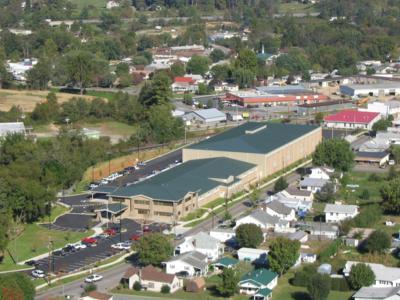 Benfield Industries, Inc.The 6-acre Benfield Industries, Inc. Superfund site is located in Waynesville, North Carolina. From 1971 to 1983, Benfield Industries mixed and packaged bulk chemicals for resale at the site. The facility handled and stored paint thinners, solvents, sealants, cleaners, de-icing solutions and wood preservatives. In 1982, a fire destroyed most on-site structures and ended industry operations at the site. After the fire, the North Carolina Department of Human Resources (NCDHR) ordered the facility owner to remove all debris and cover the site with clean soil. A state inspection in 1985 found that site activities had contaminated soil and groundwater. EPA added the site to the National Priorities List (NPL) in 1989. EPA performed additional cleanup activities, including treatment of contaminated soil and groundwater. After the soil cleanup, Haywood Vocational Opportunities (HVO) showed interest in purchasing the vacant site property for a facility expansion. The company is the largest manufacturer of custom medical drapes in the United States. HVO also provides employment opportunities and job training to people with disabilities. EPA’s work with HVO to address the company’s concerns led to HVO’s purchase of the site property at auction in 2002. The company built its manufacturing and training facilities on 4 acres. The company designated 2 acres for green space. HVO completed the site’s redevelopment in 2004. With HVO’s cooperation, EPA is working to clean up residual soil and groundwater contamination under the facility parking lot. Today, HVO is the fifth-largest employer in the county. In 2013, EPA Region 4 recognized the company with its Excellence in Site Reuse award.
Benfield Industries, Inc.The 6-acre Benfield Industries, Inc. Superfund site is located in Waynesville, North Carolina. From 1971 to 1983, Benfield Industries mixed and packaged bulk chemicals for resale at the site. The facility handled and stored paint thinners, solvents, sealants, cleaners, de-icing solutions and wood preservatives. In 1982, a fire destroyed most on-site structures and ended industry operations at the site. After the fire, the North Carolina Department of Human Resources (NCDHR) ordered the facility owner to remove all debris and cover the site with clean soil. A state inspection in 1985 found that site activities had contaminated soil and groundwater. EPA added the site to the National Priorities List (NPL) in 1989. EPA performed additional cleanup activities, including treatment of contaminated soil and groundwater. After the soil cleanup, Haywood Vocational Opportunities (HVO) showed interest in purchasing the vacant site property for a facility expansion. The company is the largest manufacturer of custom medical drapes in the United States. HVO also provides employment opportunities and job training to people with disabilities. EPA’s work with HVO to address the company’s concerns led to HVO’s purchase of the site property at auction in 2002. The company built its manufacturing and training facilities on 4 acres. The company designated 2 acres for green space. HVO completed the site’s redevelopment in 2004. With HVO’s cooperation, EPA is working to clean up residual soil and groundwater contamination under the facility parking lot. Today, HVO is the fifth-largest employer in the county. In 2013, EPA Region 4 recognized the company with its Excellence in Site Reuse award.
Last updated September 2019
As of December 2019, EPA had data on one on-site business. This business employed 416 people and generated an estimated $35,000,000 in annual sales revenue. For additional information click here.
For more information:
- Reuse and the Benefit to Community: Benfield Industries, Inc. Site (PDF) (7 pp, 365 K, About PDF)
- News Release: Haywood Vocational Opportunities, Inc. to Receive the EPA Region 4 “Excellence in Site Reuse” Award
- Superfund Site Profile Page
Celanese Corp. (Shelby Fiber Operations) 
The 450-acre Celanese Corp. (Shelby Fibers Operation) Superfund site is located in Shelby, North Carolina. The Celanese Corporation (Celanese) operated a plant on the site, producing filament thread and polyester staples for apparel and bedding products. Starting in the 1960s, Celanese discharged chemical wastes into an on-site ditch and burned and buried facility wastes on site. Between 1970 and 1979, Celanese stored drums of waste chemicals and solvents on a 3-acre part of the site. Celanese began investigating site contamination in 1981. These investigations determined that facility operations and waste disposal activities had contaminated groundwater, soil and sediment. Contaminants of concern include heavy metals, polycyclic aromatic hydrocarbons, inorganic chemicals and volatile organic compounds. In 1986, EPA placed the site on the National Priorities List (NPL). EPA and the state worked with Celanese to address contaminated soil and to build and operate a groundwater treatment system. In the mid-1990s, Celanese agreed to connect nearby residential properties to the public water supply. Groundwater monitoring is ongoing. Today, a Celanese subsidiary continues to own and operate its manufacturing facility at the site. The specialty polymer plant manufactures engineering resins for use in a variety of industries. Another company produces sewing thread in one of the on-site buildings. Several smaller contractors also operate at the site; they provide support services for the manufacturing facilities.
Last updated September 2019
As of December 2019, EPA had data on 2 on-site businesses. These businesses employed 220 people and generated an estimated $47,272,727 in annual sales revenue. For additional information click here.
For more information:
Davis Park Road TCE
The 20-acre Davis Park Road TCE Superfund site is located in Gastonia, North Carolina. The site includes residential and commercial areas affected by contaminated groundwater. In 1990, the Gaston County Environmental Health Department performed routine water sampling in a residential subdivision. The samples contained high levels of contamination. Site investigations in the early 1990s identified wastes discharged by an auto repair shop as the source of the groundwater contamination. EPA added the site to the National Priorities List (NPL) in 1999. In 2000, EPA connected surrounding residential properties to alternate water supplies. EPA also installed water treatment systems on affected wells. Long-term operation and maintenance responsibilities have been transferred to the state. Groundwater monitoring is ongoing. The Cedar Oak Park subdivision remains on site; it includes 20 acres of residential areas. Two churches and commercial businesses also operate on site.
Last updated September 2019
As of December 2019, EPA had data on one on-site business. This business employed 2 people and generated an estimated $551,000 in annual sales revenue. For additional information click here.
For more information:
General Electric Co./Shepherd Farm 
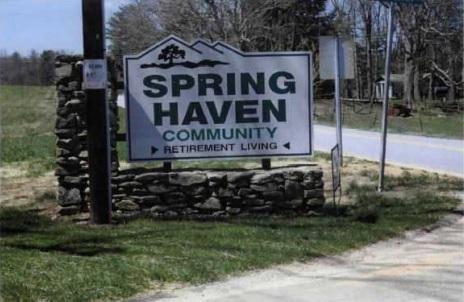 General Electric Co./Shepherd FarmThe General Electric Co./Shepherd Farm Superfund site is located in East Flat Rock, North Carolina. The site consists of two areas, or subsites. The General Electric (GE) subsite covers 110 acres. The 31-acre Shepard Farm subsite is located southwest of the GE subsite. GE disposed of facility-related wastes at both areas. These waste disposal practices contaminated soil and groundwater with hazardous chemicals. EPA placed the site on the National Priorities List (NPL) in 1994. Cleanup activities included removing and consolidating contaminated soil as well as treating and monitoring groundwater. Additional cleanup included capping remaining soil contamination and placing land use restrictions on the GE subsite. GE completed the soils portion of the cleanup in 2000. Groundwater remediation is ongoing. EPA’s carefully selected cleanup plan enabled the continued industrial and residential use of the site during cleanup. GE Lighting Systems continues to operate a manufacturing facility and distribution warehouse on the GE subsite. A manufactured housing community, a community center, and commercial and agricultural uses are located on the Shepherd Farm subsite.
General Electric Co./Shepherd FarmThe General Electric Co./Shepherd Farm Superfund site is located in East Flat Rock, North Carolina. The site consists of two areas, or subsites. The General Electric (GE) subsite covers 110 acres. The 31-acre Shepard Farm subsite is located southwest of the GE subsite. GE disposed of facility-related wastes at both areas. These waste disposal practices contaminated soil and groundwater with hazardous chemicals. EPA placed the site on the National Priorities List (NPL) in 1994. Cleanup activities included removing and consolidating contaminated soil as well as treating and monitoring groundwater. Additional cleanup included capping remaining soil contamination and placing land use restrictions on the GE subsite. GE completed the soils portion of the cleanup in 2000. Groundwater remediation is ongoing. EPA’s carefully selected cleanup plan enabled the continued industrial and residential use of the site during cleanup. GE Lighting Systems continues to operate a manufacturing facility and distribution warehouse on the GE subsite. A manufactured housing community, a community center, and commercial and agricultural uses are located on the Shepherd Farm subsite.
Last updated September 2019
As of December 2019, EPA had data on 4 on-site businesses. These businesses employed 705 people and generated an estimated $221,428,000 in annual sales revenue. For additional information click here.
For more information:
- Continued Use and the Benefit to Community: General Electric Co./Shepherd Farm Superfund Site (PDF)(10 pp, 1 MB, About PDF)
- Superfund Site Profile Page
Gurley Pesticide Burial 
The 103-acre Gurley Pesticide Burial site is located in Selma, North Carolina. A phosphate fertilizer production facility and an agricultural chemical distribution facility operated at the site. EPA did not list the site on the National Priorities List (NPL) but considers it an NPL-caliber site and is addressing it through the Superfund Alternative Approach. This approach uses the same investigation and cleanup processes and standards used for sites listed on the NPL. Soil cleanup is complete and included the excavation, treatment and off-site disposal of metals-impacted soil. The groundwater cleanup is underway and includes periodic subsurface injections to raise the pH of groundwater and reduce lead concentrations. Gravel access roads installed during cleanup were left in place for the owner’s future use. The site is in reuse – storage buildings, silos and rail spurs are located on site. The rail spurs serve the storage buildings and silos and connect to a nearby ethanol distribution facility.
Last updated September 2019
As of December 2019, EPA had data on one on-site business. This business employed 20 people and generated an estimated $3,100,000 in annual sales revenue. For additional information click here.
For more information:
Koppers Co., Inc. (Morrisville Plant)
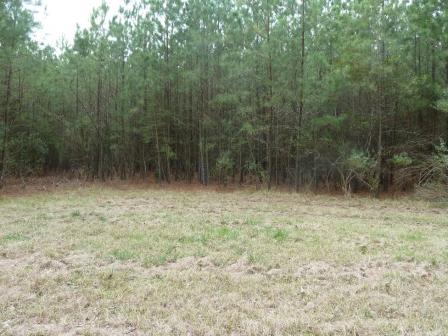 Koppers Co., Inc. (Morrisville Plant)The Koppers Co., Inc. (Morrisville Plant) Superfund site is located in Morrisville, North Carolina. Initially 52 acres, the site included two areas: the 33-acre former Unit Structures, Inc. property and the 16-acre Beazer property and nearby areas. From 1896 to 1975, several lumber companies, including the Koppers Company, the Cary Lumber Company and Unit Structures, Inc. operated at the site. In 1968, the Koppers Company’s wood-treating operations used chemical wood preservers. Operators stored wastewater in an unlined lagoon, which eventually emptied into a pond. The company installed monitoring wells around the site. In 1980, the North Carolina Department of Health and Human Services found contamination in well water samples. People living nearby use groundwater and drinking water from private wells. EPA placed the site on the National Priorities List (NPL) in 1989. Cleanup activities included removing contaminated soil, filling the ponds with clean soil and restoring wetlands. Cleanup also included connecting homes near the site to the public water supply. A groundwater treatment system began operating in May 1996. In 1997, EPA deleted the 33-acre Unit Structures, Inc. property from the NPL. A wood processing facility and an underground utility construction company currently operate on site.
Koppers Co., Inc. (Morrisville Plant)The Koppers Co., Inc. (Morrisville Plant) Superfund site is located in Morrisville, North Carolina. Initially 52 acres, the site included two areas: the 33-acre former Unit Structures, Inc. property and the 16-acre Beazer property and nearby areas. From 1896 to 1975, several lumber companies, including the Koppers Company, the Cary Lumber Company and Unit Structures, Inc. operated at the site. In 1968, the Koppers Company’s wood-treating operations used chemical wood preservers. Operators stored wastewater in an unlined lagoon, which eventually emptied into a pond. The company installed monitoring wells around the site. In 1980, the North Carolina Department of Health and Human Services found contamination in well water samples. People living nearby use groundwater and drinking water from private wells. EPA placed the site on the National Priorities List (NPL) in 1989. Cleanup activities included removing contaminated soil, filling the ponds with clean soil and restoring wetlands. Cleanup also included connecting homes near the site to the public water supply. A groundwater treatment system began operating in May 1996. In 1997, EPA deleted the 33-acre Unit Structures, Inc. property from the NPL. A wood processing facility and an underground utility construction company currently operate on site.
Last updated September 2019
As of December 2019, economic data were not publicly available for this site. For additional information click here.
For more information:
Martin-Marietta, Sodyeco, Inc. 

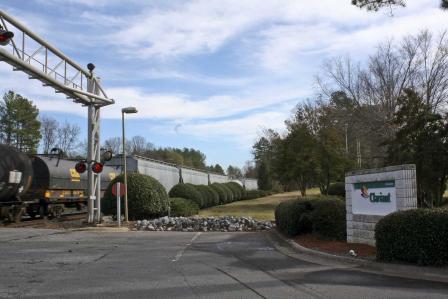 Martin-Marietta, Sodyeco, Inc.The Martin-Marietta, Sodyeco, Inc. Superfund site is located about 10 miles west of Charlotte, North Carolina. The site was home to various chemical companies for many years, beginning in 1936. In 1982, EPA found contaminants in surface water and groundwater on site. EPA placed the site on the National Priorities List (NPL) in 1983. EPA’s cleanup included capping and disposal of waste materials and soil as well as groundwater treatment. EPA removed the site from the NPL in February 2012; EPA’s Resource Conservation and Recovery Act (RCRA) program has since managed the site. Forsite Development has started redevelopment efforts at the site. The developer is turning the area into ReVenture Park, a business park focused on energy efficiency, renewable energy and environmental technology. The project is home to a biomass combined heat-and-power project, an algae-to-fuel pilot plant, a fuels and lubricants distributor, a composite walls contractor, a composting operation, a manufacturer of formwork technology, a gypsum board producer, a building materials delivery company, and a 35-acre aquaculture project, among others. Environmental stewardship is also an integral part of the site’s redevelopment. A 185-acre conservation area enhances the site’s natural resources. Projects include wildlife habitat, stream restoration and a trail system connecting the regional Carolina Thread Trail across the site to the nearby U.S. National Whitewater Center.
Martin-Marietta, Sodyeco, Inc.The Martin-Marietta, Sodyeco, Inc. Superfund site is located about 10 miles west of Charlotte, North Carolina. The site was home to various chemical companies for many years, beginning in 1936. In 1982, EPA found contaminants in surface water and groundwater on site. EPA placed the site on the National Priorities List (NPL) in 1983. EPA’s cleanup included capping and disposal of waste materials and soil as well as groundwater treatment. EPA removed the site from the NPL in February 2012; EPA’s Resource Conservation and Recovery Act (RCRA) program has since managed the site. Forsite Development has started redevelopment efforts at the site. The developer is turning the area into ReVenture Park, a business park focused on energy efficiency, renewable energy and environmental technology. The project is home to a biomass combined heat-and-power project, an algae-to-fuel pilot plant, a fuels and lubricants distributor, a composite walls contractor, a composting operation, a manufacturer of formwork technology, a gypsum board producer, a building materials delivery company, and a 35-acre aquaculture project, among others. Environmental stewardship is also an integral part of the site’s redevelopment. A 185-acre conservation area enhances the site’s natural resources. Projects include wildlife habitat, stream restoration and a trail system connecting the regional Carolina Thread Trail across the site to the nearby U.S. National Whitewater Center.
Last updated September 2019
As of December 2019, EPA had data on 8 on-site businesses. These businesses employed 30 people and generated an estimated $4,277,469 in annual sales revenue. For additional information click here.
For more information:
- Reuse and the Benefit to Community: A Beneficial Effects Economic Case Study for the Martin-Marietta, Sodyeco, Inc. Superfund Site (PDF)(10 pp, 1.5 MB)
- Site Redevelopment Profile for the Martin-Marietta Sodyeco Superfund Site (PDF)(3 pp, 2.2 MB)
- Reclaim, Restore, Reinvent: Creating Jobs and Cleaner Energy - The Martin-Marietta, Sodyeco, Inc. Site in Charlotte, North Carolina (PDF) (16 pp, 5.7 MB)
- News Release: Forsite Development, Inc. to Receive EPA Region 4's "Excellence in Site Reuse" Award
- Superfund Site Profile Page
National Starch & Chemical Corp. 
The National Starch & Chemical Corp. Superfund site is part of a 500-acre property in Salisbury, North Carolina. The site includes two facilities that have been actively making specialty chemicals for the textile and furniture industries since 1970. On-site disposal of chemicals used in the manufacturing and cleaning processes at the plants resulted in contamination of a 20-acre area. EPA added the site to the National Priorities List (NPL) in 1989. Cleanup includes containing and treating contaminated groundwater on site. Precipitation flushes contamination from the soils. The resulting contaminated water is captured by the groundwater containment system. A soil vapor extraction system is removing contamination under the plant. Soil and groundwater monitoring occur regularly. EPA’s cleanup plan enabled the continued operation of the two chemical manufacturing plants on site.
Last updated September 2019
As of December 2019, EPA had data on 2 on-site businesses. These businesses employed 355 people and generated an estimated $233,914,000 in annual sales revenue. For additional information click here.
For more information:
Weyerhaeuser Co. Plymouth Wood Treating Plant 
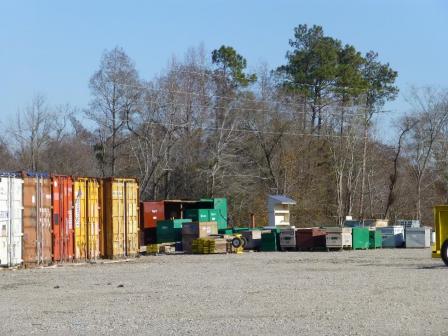 Weyerhaeuser Co Plymouth Wood Treating PlantThe Weyerhaeuser Company (Co.) Plymouth Wood Treating Plant site is located in Plymouth, North Carolina. A paper mill and paper products manufacturing facility has operated at the site since 1937. Past waste disposal practices included wastewater discharges into the Roanoke River and Welch Creek. Operators also disposed of facility-related wastes in an on-site landfill. Facility operations and waste disposal practices contaminated soil, sediment, surface water, groundwater and fish. EPA considered adding the site to the National Priorities List (NPL) but decided to address the cleanup under alternative cleanup approaches. Domtar Corporation, the current site owner, leads the cleanup with oversight from EPA and the North Carolina Department of Environmental Quality. Cleanup activities included capping contaminated materials at the former landfill, installing a sheet pile wall below the former chlorine plant area next to the Roanoke River, and placing a sand cap over contaminated sediments in Welch Creek. A fish consumption advisory is in place. Land use restrictions limit future land uses to industrial and commercial uses. Long-term monitoring of groundwater, sediment and fish is ongoing. Today, the facility uses the gravel part of the landfill cap for parking and storage of construction materials.
Weyerhaeuser Co Plymouth Wood Treating PlantThe Weyerhaeuser Company (Co.) Plymouth Wood Treating Plant site is located in Plymouth, North Carolina. A paper mill and paper products manufacturing facility has operated at the site since 1937. Past waste disposal practices included wastewater discharges into the Roanoke River and Welch Creek. Operators also disposed of facility-related wastes in an on-site landfill. Facility operations and waste disposal practices contaminated soil, sediment, surface water, groundwater and fish. EPA considered adding the site to the National Priorities List (NPL) but decided to address the cleanup under alternative cleanup approaches. Domtar Corporation, the current site owner, leads the cleanup with oversight from EPA and the North Carolina Department of Environmental Quality. Cleanup activities included capping contaminated materials at the former landfill, installing a sheet pile wall below the former chlorine plant area next to the Roanoke River, and placing a sand cap over contaminated sediments in Welch Creek. A fish consumption advisory is in place. Land use restrictions limit future land uses to industrial and commercial uses. Long-term monitoring of groundwater, sediment and fish is ongoing. Today, the facility uses the gravel part of the landfill cap for parking and storage of construction materials.
Last updated September 2019
As of December 2019, EPA did not have economic data related to on-site businesses, or economic data were not applicable due to site use. For additional information click here.
For more information:
Wright Chemical Corporation
The 758-acre Wright Chemical Corporation site is located about 1 mile south of Riegelwood, North Carolina. The site is next to Livingston Creek (a tributary of the Cape Fear River). The site includes two properties – a 720-acre northern property and a 38-acre southern property. A railroad corridor separates the two properties. From the 1880s to 1991, several companies operated acid and fertilizer manufacturing facilities on both parts of the site. Facility operations resulted in the contamination of groundwater, surface water, soil, sediment and aquatic biota. EPA added the site to the National Priorities List (NPL) in 2011. Site investigations and cleanup planning are ongoing. Active businesses on site include two chemical manufacturing facilities. Livingston Creek includes a wetland and a fishery.
Last updated September 2019
As of December 2019, EPA had data on 2 on-site businesses. These businesses employed 36 people and generated an estimated $16,475,000 in annual sales revenue. For additional information click here.
For more information:
